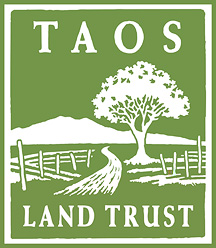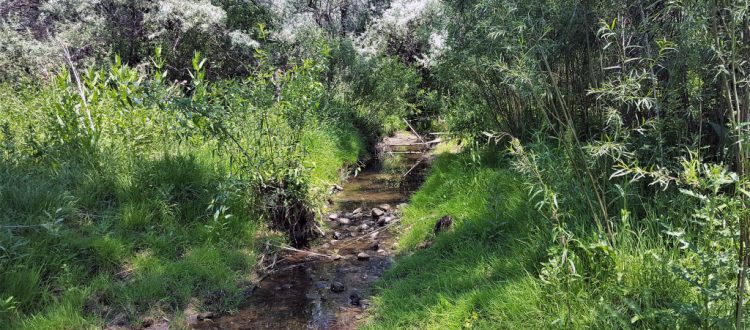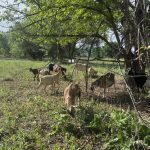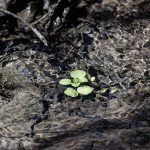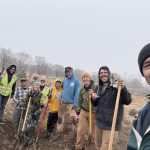Rio Fernando River Restoration: Getting Down to the Details
The Rio Fernando is a life-source running through the heart of Taos. Starting at the top of La Jara Canyon and running through Cañon, the Fernando slowly makes its way through town to the Rio Pueblo and eventually the Rio Grande.
Although the history of the Rio Fernando is complex, we know that there have been vibrant species such as the Rio Grande Cutthroat Trout thriving along its banks. Currently, the species that call the Rio Fernando home, like the North American Beaver, Northern Goshawk, and various native minnows, have found ways to adapt to less than ideal water quality and river flow. Over time, the Rio Fernando has been impaired by overgrazing at the headwaters and along the upper corridor, aging septic systems, and heavy private development. According to the criteria set by the EPA through the Clean Water Act, there have been numerous E. coli exceedances at different points along the river as a result. Channelization (a result of fast moving water that erodes river banks, deepening the waterway), eutrophication (excessive build-up of nutrients in water that chokes out oxygen), and sedimentation (a product of erosion upstream which causes an imbalance in sediments) that contribute to less than ideal conditions for aquatic life to survive.
Despite these challenging circumstances, life has persisted and can be recognized in the wetlands of the lower section of the Rio Fernando that hug the banks along the Taos Land Trust property and Fred Baca Park. These wetlands have excellent natural sponge-like capabilities for storing water and providing a buffer for the land against high-intensity storm events. In light of impending climate change, wetlands will be of ever-increasing value to our resiliency and ability to store water for the future. With this future in mind, Taos Land Trust has chosen to further strengthen this amazing resource by commencing the Rio Fernando river restoration of the wetlands along our property off La Posta Rd. This important corridor provides habitat for wildlife and is a strong point of connection between the animal and human worlds. By restoring this wetland, we are also restoring peoples’ ability to reconnect with a life-source such as the Rio Fernando and feel a deeper sense of responsibility towards fostering this resource.

Historically, there has been a long-held belief that by straightening out river banks and draining wetlands it makes more room for agriculture to take place on the land. This was largely inspired by the advertising campaigns of dynamite companies in the 1930s that stated meandering rivers are a menace to society because they reduced the river capabilities of holding flood water (American Forests, 1935; Popular Mechanics, 1939). This ploy to increase profits within the dynamite industry proved extremely harmful as more and more rivers and streams across the USA were straightened and stripped of their true water holding capacity.
This too is the story of the Rio Fernando as we have been able to tell from historic aerial photographs of the river revealing a point in time when the river meandered for the majority of its run through town. The meandering of the river slowed water down on its journey downstream and allowed for more water to infiltrate back into groundwater. It also allowed for more diverse riparian habitat to shade the river and create a hospitable environment for fish and other aquatic life to thrive. Since that natural design was taken away some time after the late 1930s, it has taken a while for humans to revert to the meandering form that nature intended for our waterways. For restoration projects state and nation-wide that bring back the meandering of rivers and streams, there have been remarkable results in overall ecosystem function.
For the section of the Rio Fernando that runs through the TLT property, we recently brought in riparian restoration expert Bill Zeedyk, whose work for more than a decade has focused on “induced meandering” – a technique using wood and rock structures strategically placed within the banks to help damaged waterways regain a healthy flow over time. His time on the property informed the upcoming restoration work to not only include methods of induced meandering but the critical role that beavers, a species that calls our property home, will play in aiding our efforts. A beaver dam is an excellent way to slow down water and allow it to stay within the land and wetlands longer. It also is a natural cleanser of water as it passes through the intricacies of the natural dam. The work beavers are already doing on the property will prove to be helpful in filtering sediment and slowing the flow of water to make for a healthier wetland.

Heading the restoration efforts that will begin this Spring, the group Keystone Restoration Ecology will take the work of the beavers into account and use other nature-inspired techniques in the restoration efforts. This must begin with the strategic removal of invasive species such as Siberian Elm and Russian Olive which have outcompeted native species that formerly tied the ecosystem together. This will be part in parcel with the reintroduction of native species like Coyote Willow which provide habitat and food for other species like the beavers. Part of the restoration work will also include moving the Rio Fernando back to its original stream channel which can be seen in aerial photographs from before it was straightened. This will bring back a natural meander and floodplain that supports a larger wetland area and therefore a greater ecological and storm water retention capacity. As we approach the on the ground stage of the Rio Fernando river restoration, we will be involving a YCC crew and a Taos Pueblo youth corps crew to work on some of the hands-on labor of the restoration as well as learning opportunities that demonstrate the importance of this kind of work. From our wetland to the communities upstream and downstream, we hope to see an echo of positive effects that restore the connection between what nature has to offer and what we can do to better nurture that help.

